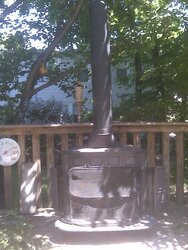firecracker_77
Minister of Fire
Hi Firecracker,
yes it would look great in the right house wouldnt it, knew I had seen one on the Stovax site, didnt know if you still had them in production in the US, so thought I would attach the link.
Bet they get through a fair bit of wood though !.
I'm sure it would use quite a bit. I probably wouldn't burn that everyday. More to create an ambiance on a Saturday night or something like that. I'd never give up a woodstove as they don't send heat up the chimney from the other parts of the home. I really want to try the hearth cooking this year.




 , even in single digit outside temps. I miss the massive fast heat it made, but don't miss burning a wheelbarrow full of wood in one night.
, even in single digit outside temps. I miss the massive fast heat it made, but don't miss burning a wheelbarrow full of wood in one night.
